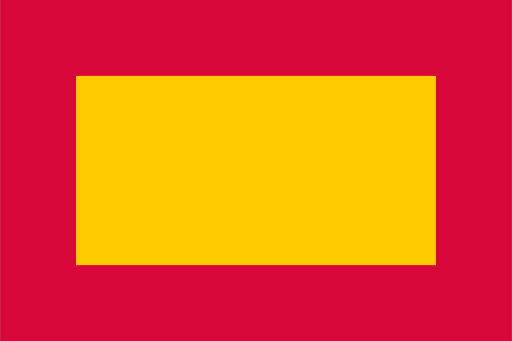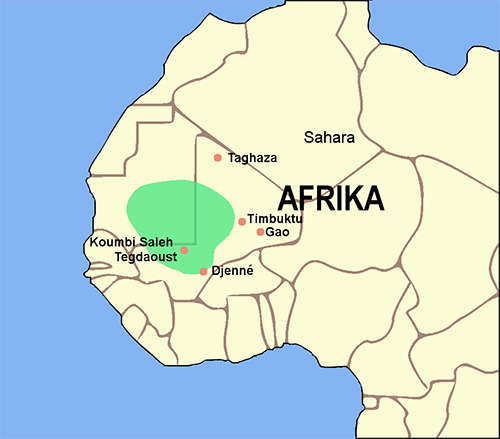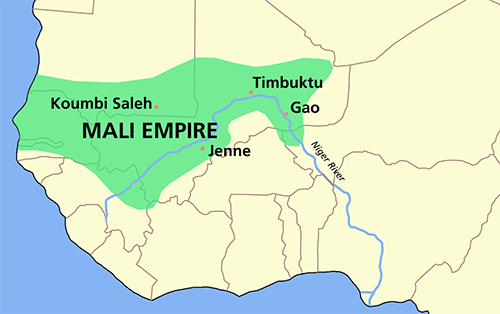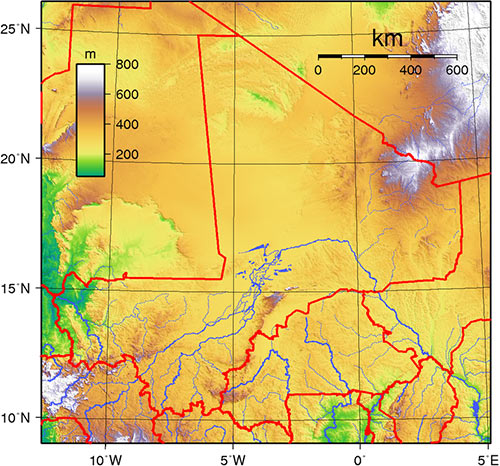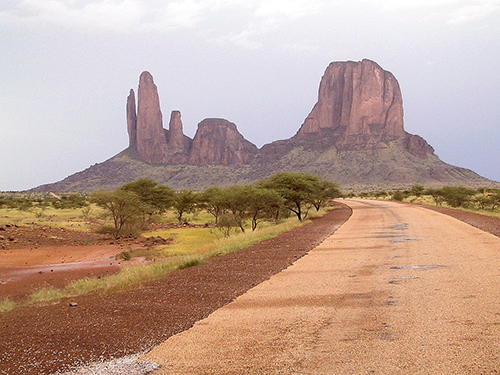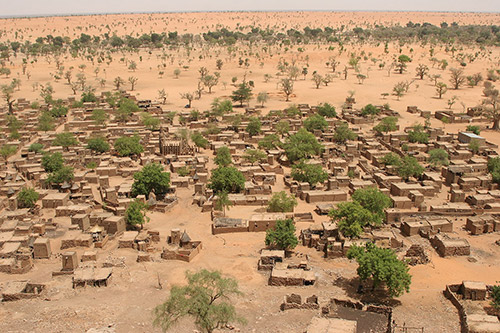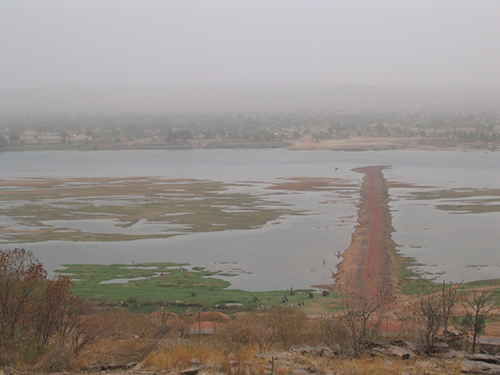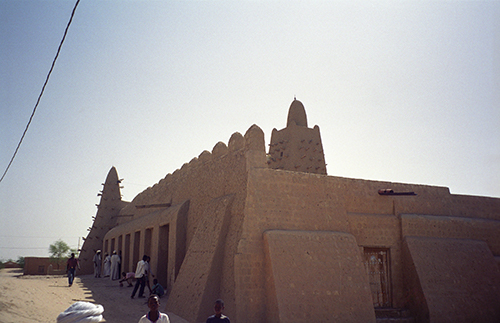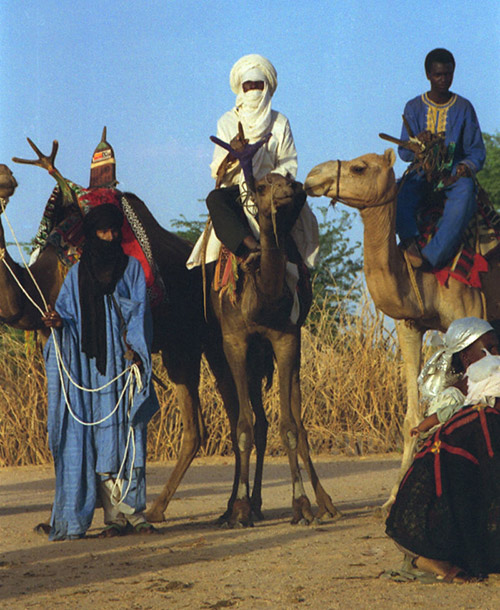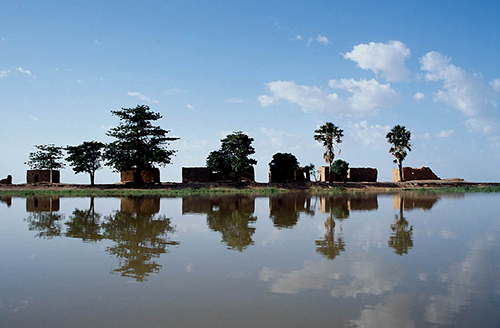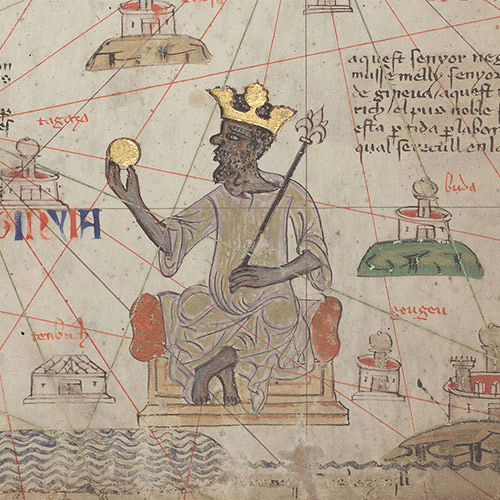Series 1: Mali
The Medieval Mali Empire was founded around 1240 by Sunjata Keita, prince of a royal Malinke family. Building on the legacy of the older Empire of Ghana, Mali ruled much of inland West Africa during the 13th through 16th centuries.
A rich trade kingdom visited by travelers as far away as Arabia, Mali was famous as a source of gold in Europe and throughout the Islamic world. Our first series will cover this great civilization, starting with the disintegration of Ghana all the way to Mali’s own collapse in 1599.
Maps
What would a history podcast be without plenty of maps? All are licensed under Creative Commons from Wikipedia. Link to original file on each image.
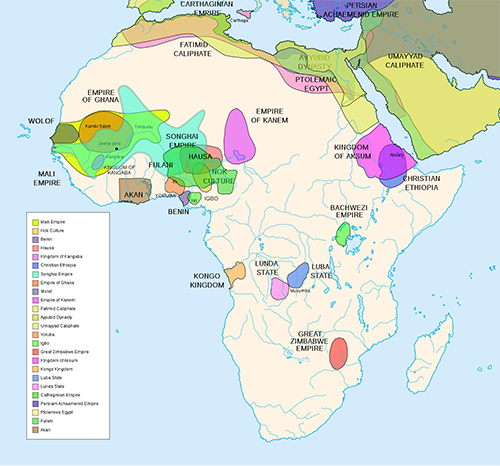
Gallery
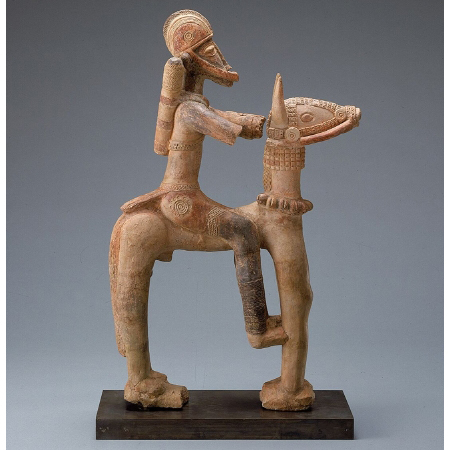
Glossary
- Almoravids
A Berber empire in Morocco, Spain and West Africa founded in the early 11th century by members of the nomadic Berber Sanhaja confederation. An Almorvaid invasion is often attributed for bringing down the Ghana Empire.
- Bambuk
One of the two main goldfields in imperial Mali. Smaller than its twin site of Bure, Bambuk produced a significant amount of gold for the Mansa nonetheless. The modern fields of Bambuk are still being mined, though their production is nowhere near as intense as they once were. - Berbers
An ethnic group native to North Africa and the Sahara. Nomadic Berbers, including the Tuareg, carried goods between the Sahel and the Maghreb throughout the last 1400 years. Settled Berber states in the Maghreb, including Morocco, also played an important role in West African history, including the famous 1592 invasion of Songhay. - Bure
The largest goldfield of imperial Mali. According to the Soninke legends, the head of Bida the snake rests in this site and was the source of Mali’s wealth. Bure produced the majority of Mali’s gold and, indeed, was the largest single source of gold in the Old World during the 14th century.
- Caste
A caste is a hereditary social group defined by occupation. Members of castes are usually required to marry only within their caste and often can only perform certain jobs in a society. Castes in West Africa likely started with the Malinke and spread with the empire. Malinke castes include the Jeliw, Blacksmiths and Leatherworkers.
- Ghana (AKA Wagadu, Kaya-Magha)
The first named empire in West African history. The Ghana Empire flourished sometime between 500 and 1200 AD. It was the first empire Arab authors wrote about and was the source of gold for the Trans-Saharan trade during this period. It may have been destroyed following an Almoravid/Takruri invasion in 1077, but may have lingered for another century afterwards.
- Hajj
The Hajj is the sacred pilgrimage to Mecca required of all Muslims who can afford it. The first kings in West Africa to undertake the Hajj came from Mali and were famous throughout their empire. Later, during the reign of Mansa Musa, the Hajj became a PR tool used by the Mansa in order to legitimize their authority.
- Inland Delta
The region along the Middle Niger river, close to modern Jenne, where the Niger breaks off into many tributaries. The riverbanks flood regularly and the area is home to many lakes. Due to the flooding and wetland environment, rich soils are deposited in this region and the area, known locally as Macina, is very fertile.
- Jeli/Jeliw
The caste of bards among the Mande peoples. Jeliw are tasked with remembering histories, genealogies, poems and songs for the entertainment and legitimization of their liege, generally a local noble. Jeliw are born into their positions and many famous families are attached to specific clans, such as the Keita. - Jula
The merchant class of the Malinke. The jula traveled across West Africa to establish trade connections with producers of salt and gold, and then carried these minerals north to exchange with Arab and Berber merchants in Jenne and Timbuktu. The Jula were instrumental in spreading Mande civilization and, following Mali’s collapse, founded several independent states of their own in Guinea, Ghana and The Gambia.
- Kafu
The original political system of the Malinke. A kafu is composed of a series of networked villages under the command of a single chief or king. Kafus were generally small and rarely possessed a population beyond the 10,000s. Following the collapse of the Mali Empire, the Malinke reverted back to the Kafu system that they had used before the foundation of the empire. - Keita
The Keita are the royal family of Mali. Many popular etymologies exist to explain the name, including one that claims it means “Seize your destiny” and was given to Sunjata following his return from Mema. The Keita claim descent from Bilal ibn Rabah, the first muezzin in Islam.
- Maghreb
The Mediterranean coast of North Africa, generally considered to be everything between the mountains and desert and west of Egypt. The Maghreb is fertile and shares a climate with much of Southern Europe. Settled kingdoms in the region interacted regularly with Mali and were often the origin point of caravans to the Empire. - Mali
The medieval Empire for which the modern nation is named. Mali was a kingdom lasting from roughly 1240-1599 and became famous the world over due to its massive quantities of gold. Beyond gold, the empire was also home to a thriving scholarly community and left an important legacy for the political and social structures of the region. - Malinke
The ethnic group which founded the Mali Empire. The Malinke come from the region of the Guinea Highlands. Malinke means “People of Mali”. Other names for the Malinke include Mandingo, Mandinka, Maninka and others. - Mande
A language group throughout West Africa. The Mande peoples are those who speak the Mande languages. The Mande include ethnicities such as the Soninke, Malinke, Bozo and Bambara. Due to their connection to Ghana and Mali, the Mande were the first major state-builders in this region. Their culture and social structures influenced those of their neighbors and those as far afield as the Akan in modern Ghana. - Manden
The legendary homeland of the Malinke, generally found in the area around modern Kangaba all the way down to the modern village of Niani. - Mansa
The title of the kings of Mali. Originally just the title of the lord of a Kafu, Mansa became tied with the king of all the Malinke alone following Sunjata’s unification of the country in the 13th century. - Mema
A successor state to Ancient Ghana. Some have speculated that it was to Mema Arab authors referred when they talked about “Ghana” after 1077 and the Almoravid invasion. Mema offered aid and arms to Sunjata during his war with Soso and became an influential power within the Empire of Mali as a result.
- Niani
The purported capital of the Mali Empire. Archaeologists have found little evidence at the site to suggest the village was once an imperial capital. Moreover, recent interpretations of Arabic records suggest that the previous reading of the capital as “YNY” may have been mistaken, suggesting instead that the capital was somewhere near the Inland Delta.
- Sahel
The semi-arid grasslands between the savannah and Sahara in West Africa. The Sahel was the location of West Africa’s first civilization, Ghana, and was the primary site of cross-cultural exchange throughout the medieval and early modern period in this region. - Songhay
The empire which succeeded Mali in West Africa. The Songhay are an ethnic group native to east of the Niger Bend. The Songhay Empire was a major rival to the declining Mali Empire in the 16th century, but never managed to completely destroy them. Songhay was destroyed in 1592 following an unexpected Moroccan invasion from the north. - Soninke
The Soninke are a Mande people who founded the Ghana Empire. Once concentrated around the northern Sahel, they are today dispersed throughout the region, having scattered following the collapse of Ghana. - Soso
The Soso were a Soninke people who founded the kingdom of Soso. Led by their king Sumaworo, Soso nearly conquered all the lands of old Ghana and almost destroyed the Malinke as well. Their war with the Malinke, led by the prince Sunjata, forms the backdrop of the Epic of Sunjata. - Sunjata
Sunjata Keita was the founder of the Mali Empire. Born, according to legend, immobile he learned to walk despite his disabilities and became a champion hunter and warrior. His defeat of the Soso king Sumaworo led to the foundation of the Mali Empire.
- Takrur
Takrur was a kingdom in the Senegal river valley. One of the first Muslim kingdoms in Africa, Takrur may have played a part in the destruction of Ghana in 1077. - Tuareg
The Tuareg are a subgroup of nomadic Berbers who speak their own language and live in a massive territory spanning modern Mali, Morocco, Algeria, Chad and Niger. Known for the blue veils their men wear, they historically made a living herding animals and carrying goods across the desert, as well as raiding their neighbors.
Bibliography
Books
- Levtzion, Nehemia. Ancient Ghana and Mali. London: Methuen. 1980.
- Gomez, Michael. African Dominion: A New History of Empire in Early and Medieval West Africa. Princeton: Princeton University Press. 2018.
- Hopkins, J.F.P., Levtzion, Nehemia. Corpus of Early Arabic Sources for West African History. Princeton: Markus Wiener. 2000.
- Translated by David Conrad. Sunjata: A New Prose Version. Cambridge: Hackett Publishing. 2016.
Articles
- Austen, Ralph A., Jansen, Jan. “History, Oral Transmission and Structure in Ibn Khaldun’s Chronology of Mali Rulers.” History in Africa. Vol 23. (1996): 17-28.
- Bell, Nawal Marcos. “The Age of Mansa Musa of Mali: Problems in Succession and Chronology.” The International Journal of African Historical Studies. Vol. 5 No. 2 (1972): 221-234.
- Elbl, Ivana. “Cross-Cultural Trade and Diplomacy: Portuguese Relations with West Africa, 1441-1521.” Journal of World History. Vol. 3 No. 2. (Fall 1992): 165-204.
- Elbl, Ivana. “The Horse in Fifteenth Century Senegambia.” The International Journal of African Historical Studies. Vol. 24. No. 1. (1991): 85-110.
- Fisher, Humphrey J. “He Swalloweth the Ground with Fierceness and Rage’ The Horse in the Central Sudan II. Its Use.” The Journal of African History. Vol. 14. No. 3. (1973): 355-379.
- Goody, Jack. “Economy and Feudalism in Africa.” The Economic History Review. Vol. 22. No. 3. (Dec. 1969): 393-405.
- Hunwick, J. O. “The Mid-Fourteenth Century Capital of Mali.” The Journal of African History. Vol. 14. No. 2 (1973): 195-206.
- Law, Robin. “Horses, Firearms and Political Power in Pre-Colonial West Africa.” Past and Present. No. 72. (1976): 112-132.
- Levtzion, Nehemia. “The Thirteenth- and Fourteenth – Century Kings of Mali”, The Journal of African History. Vol 4. No. 3 (1963): 341-353.
- McIntosh, Roderick J. McIntosh, Susan Keech. “The Inland Niger Delta before the Empire of Mali: Evidence from Jenne-Jeno.” The Journal f African History. Vol. 22. No. 1. (1981): 1-22.
- Tamari, Tal. “The Development of Caste Systems in West Africa.” The Journal of African History. Vol. 32. No. 2. (1991): 221-250.
- Wilks, Ivor. “Wangara, Akan and Portuguese in the Fifteenth and Sixteenth Centuries. 1. The Matter of Bitu.” The Journal of African History. Vol. 23. No. 3. (1982): 333-349.
- Wilks, Ivor. “Wangara Akan and Portuguese in the Fifteenth and Sixteenth Centuries. 2. The Struggle for Trade.” The Journal of African History. Vol 23. No. 4 (1982): 463-472.


